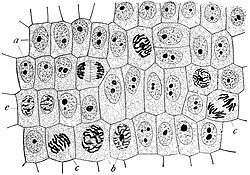| Cell | |
|---|---|
 | |
 A eukaryotic cell (left) and prokaryotic cell (right) | |
| Identifiers | |
| MeSH | D002477 |
| TH | H1.00.01.0.00001 |
| FMA | 686465 |
| Anatomical terminology | |
The cell is the basic structural and functional unit of all forms of life. Every cell consists of cytoplasm enclosed within a membrane; many cells contain organelles, each with a specific function. The term comes from the Latin word cellula meaning 'small room'. Most cells are only visible under a microscope. Cells emerged on Earth about 4 billion years ago. All cells are capable of replication, protein synthesis, and motility.
Cells are broadly categorized into two types: eukaryotic cells, which possess a nucleus, and prokaryotic cells, which lack a nucleus but have a nucleoid region. Prokaryotes are single-celled organisms such as bacteria, whereas eukaryotes can be either single-celled, such as amoebae, or multicellular, such as some algae, plants, animals, and fungi. Eukaryotic cells contain organelles including mitochondria, which provide energy for cell functions; chloroplasts, which create sugars by photosynthesis, in plants; and ribosomes, which synthesise proteins.
Cells were discovered by Robert Hooke in 1665, who named them after their resemblance to cells inhabited by Christian monks in a monastery. Cell theory, developed in 1839 by Matthias Jakob Schleiden and Theodor Schwann, states that all organisms are composed of one or more cells, that cells are the fundamental unit of structure and function in all living organisms, and that all cells come from pre-existing cells.